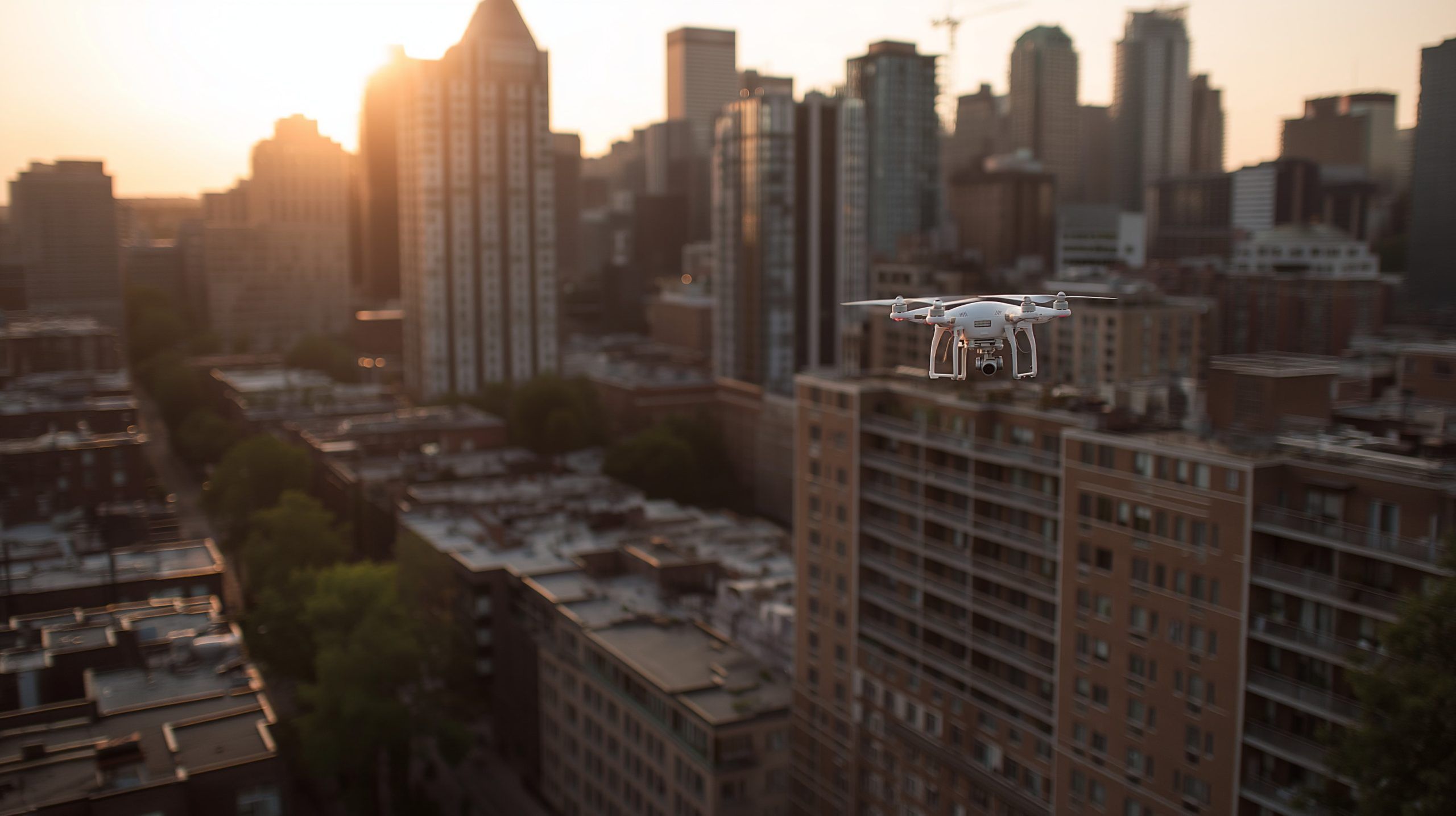- Montreal bans recreational drones in all city parks, with takeoff, landing, or flight in parks prohibited without special permission.
- The Old Port of Montreal prohibits drone use on its site unless authorized by the Corporation, so flying around Old Montreal/Old Port requires permission.
- Olympic Park bans drones on its grounds at all times unless you have written authorization from Parc Olympique administration.
- Montreal city property requires authorization for any drone takeoff or landing, making launches from sidewalks or public squares potentially unlawful without permission.
- Canada’s national parks are no‑fly zones, and drones cannot take off or land inside Parks Canada sites without explicit permission.
- Drones must respect airspace rules around Montreal, staying at least 5.6 km from airports and 1.9 km from heliports, and obeying a 122 m (400 ft) altitude limit with night flights only when lit.
- Drones weighing 250 g to 25 kg must be registered with Transport Canada, and pilots must hold a Basic or Advanced Pilot Certificate, with Basic allowing uncontrolled airspace and 30 m from bystanders and Advanced allowing more operations after a flight review.
- Fines and penalties were raised in 2025, with individuals up to 3,000 CAD per infraction, corporations up to 15,000 CAD, and criminal charges up to 25,000 CAD and/or imprisonment for egregious offenses, plus possible municipal fines.
- Flying over advertised events now requires a Special Flight Operations Certificate, and micro drones under 250 g are not exempt from event restrictions and may require permission.
- Phase 2 of the 2025 rules takes effect on November 4, 2025, expanding BVLOS under Level 1 Complex Operations with an RPAS Operator Certificate, adding EVLOS and Sheltered operations, and extending the 25–150 kg drone category to visual line of sight under strict conditions.
Drones are a thrilling way to capture Montreal’s skyline and parks from above – but if you’re not careful, your flying camera could land you in serious legal trouble. Montreal’s drone laws in 2025 combine strict federal regulations with local bans that could ground your drone before it ever takes off. Recent rule changes have introduced tighter restrictions, hefty fines up to five figures, and new requirements for pilots. This report breaks down everything you need to know – from Canada-wide rules that apply in Montreal, to city-specific no-fly zones, licensing steps for hobbyists vs. commercial users, and practical tips to avoid penalties. Don’t launch your drone in Montreal until you’ve read these must-know rules!
Overview of Canada’s Drone Rules (Applied in Montreal)
Federal Law – Transport Canada: In Canada, drones are regulated at the national level by Transport Canada under the Aeronautics Act and the Canadian Aviation Regulations (CARs) Part IX [1]. Drones are considered “aircraft”, meaning pilots must follow many of the same safety rules as manned aviation [2]. These rules apply in Montreal just as they do across Canada, covering all drones weighing between 250 g and 25 kg, whether you’re flying for fun or for work [3]. (Drones under 250 g – “microdrones” – are exempt from registration and licensing, but you still must fly them safely and not endanger people or aircraft [4].)
Basic Safety Rules:Drone pilots must always fly responsibly. Key federal rules include keeping your drone within visual line-of-sight at all times, never flying higher than 122 m (400 ft) above ground, and yielding to other aircraft [5]. You must also stay far from bystanders (generally at least 30 m away for basic operations) and avoid flying over crowds [6]. Flying at night is allowed only if your drone has lights [7]. Importantly, you cannot fly near airports or heliports without special permission – generally keep at least 5.6 km from any airport and 1.9 km from any heliport to avoid interfering with manned aircraft [8]. These baseline rules are in force nationwide and Transport Canada takes them seriously, investigating reports of unsafe flying and involving local police if other laws (like privacy or negligence) are broken [9].
Licensing and Registration: Unlike in some countries, Canada does not separate “recreational” vs. “commercial” drone laws – the rules are based on weight and risk, not purpose. Anyone flying a drone 250 g to 25 kg must obtain a drone pilot certificate and register the drone with Transport Canada [10] [11]. We’ll cover the licensing levels in detail later, but in short, you need to pass a knowledge exam (and for advanced operations, a flight review) to get certified. You must also mark your drone with its registration number and carry proof of registration and your pilot certificate when flying [12] [13]. Canada’s framework essentially treats drone pilots the same as other aviators – you have legal responsibilities each time you take off [14].
“Respect All Other Laws”: Transport Canada emphasizes that drone pilots must obey not just aviation rules but all other applicable laws [15]. This means in Montreal you must respect criminal laws (no mischief, voyeurism or dangerous behavior [16]), provincial statutes (like trespassing or privacy acts), and any relevant municipal bylaws. As we’ll see, Montreal and other cities can regulate where drones take off/land or ban them in certain areas for local safety and privacy reasons [17] [18]. Always ensure your drone activities comply with all levels of law.
Montreal’s Municipal Drone Restrictions
Federal drone laws are just the beginning – the City of Montreal has its own rules that directly affect where you can fly. Montreal’s municipal government cannot override federal air safety regulations, but it can restrict drone use on city property (parks, etc.) and address local nuisances. Here are the key local restrictions in Montreal as of 2025:
- No Drones in City Parks: Montreal has banned recreational drone flying in all its municipal parks. According to the official city policy, “to protect users’ privacy and to keep our parks peaceful, recreational drones or motorized model aircraft are prohibited” in any city park [19]. In practical terms, you are not allowed to take off, land, or fly a drone within Montreal’s parks without special permission. This ban covers popular green spaces like Mount Royal Park, Jean-Drapeau Park, neighbourhood parks, etc. Violating this bylaw could result in municipal fines or other enforcement.
- Old Port of Montreal – Permission Required: The Old Port is a federal historic waterfront area and a major Montreal attraction – and it has its own set of site rules. The Old Port’s regulations explicitly forbid drone use on its property without authorization from the Old Port’s management. “It is forbidden to use drones, motorized model aircraft, rockets, or kites on the site without authorization from the Corporation,” the Old Port rules state [20]. So, you cannot fly your drone around Old Montreal/Old Port (including the Bonsecours Basin, Clock Tower Beach area, etc.) unless you have obtained permission from the Old Port authority. This is to ensure public safety in the busy tourist area. Flying there without permission may get you removed by security and reported.
- Olympic Park Ban: The site of Montreal’s Olympic Stadium and related attractions (Biodôme, Planetarium, etc.) also prohibits drones. The Olympic Park has a policy that no drones may be flown anywhere on its grounds without written authorization from the Olympic Park administration [21]. This ban even includes small <250 g drones and applies “at all times, across the entire site” [22]. Even if you somehow obtain NAV CANADA airspace authorization, you still need the venue’s written permit to fly there [23]. The Olympic Park is within controlled airspace and near big crowds, so they enforce this strictly. They invite drone pilots to apply via a form a few days in advance, providing proof of Transport Canada compliance, to possibly get permission for specific projects [24]. Without that, expect security or police intervention if you fly a drone at the Olympic Stadium [25].
- Other City Property: In general, Montreal requires an authorization for any drone take-off or landing on city-owned property [26]. While the blanket statement from a Quebec drone community site notes that an official city permit is needed to operate in the metropolis [27], the practical enforcement is mostly seen in parks and special sites as noted above. This means if you plan to launch your drone from a city sidewalk, street, or public square, you could be violating city bylaws (even if the actual flight through the air is regulated federally). Montreal, like many cities, uses its power over land use to control drones: for example, it can cite you for causing a public disturbance or using park space improperly. Bottom line: Outside of private property, there are very few places within Montreal city limits where you can legally launch or land a drone without some form of permission.
Landmark and Sensitive Location Restrictions: Beyond parks, be mindful of other sensitive locations in Montreal that effectively forbid drones. Hospitals and police stations may react strongly to unauthorized drones (especially if near helipads or security zones). The Montreal-Trudeau Airport zone obviously bans any unapproved drones (more on airspace below). Also, federal and provincial sites like courts, critical infrastructure, or even prisons have strict no-drone policies (flying a drone to drop contraband into a prison is a criminal offense, for instance). While not all such restrictions are posted on signs, drone pilots are expected to know and avoid these sensitive areas as part of flying safely. When in doubt, assume you cannot fly over government or high-security premises without explicit clearance.
Recreational vs. Commercial Drone Use: Same Rules Apply
One common question is whether hobby drone pilots face different rules than commercial (for-profit) drone operators. In Canada, the answer is straightforward: there is one set of drone regulations for all pilots, regardless of purpose. Canadian regulations do not distinguish between recreational and commercial drone use in terms of operating rules – everyone must follow the same safety regulations [28]. Whether you’re an individual flying for fun, a photographer doing real estate shots, or a company doing inspections, the legal requirements (pilot licensing, drone registration, airspace rules, etc.) are the same [29]. The critical factors are the drone’s weight and the type of operation (basic vs. advanced), not whether you’re getting paid [30] [31].
Implications for Hobbyists: Prior to 2019, Canada had more lenient “model aircraft” rules for recreational flyers, but the modern regulations have unified standards. This means as a hobbyist in Montreal, if your drone is 250 g or above, you must pass a Transport Canada exam to get certified and you must register your drone, just like any commercial pilot [32] [33]. You’re also held to the same restrictions on airspace, altitude, and distance from people. For example, a 16-year-old flying a camera drone in their backyard has to obey the same 122 m altitude limit and no-fly zones as a professional film crew would. There is no “permission-free” recreational zone within the city just because it’s hobby use – all federal and local rules still apply.
Implications for Commercial Operators: If you’re flying a drone for business or any commercial project in Montreal, you don’t need a separate “commercial drone license” – you simply need the standard Basic or Advanced Pilot Certificate that any pilot would, depending on your operation type [34]. In fact, many commercial operations (e.g. aerial filming downtown, inspections near structures, etc.) will fall under “Advanced Operations” due to being in controlled airspace or near people. That means you will likely need the Advanced Certificate, NAV CANADA clearances, and a drone that meets advanced safety design requirements – more on that below [35] [36]. Additionally, commercial drone users should consider factors like liability insurance and film/photography permits. For instance, to film with a drone in Montreal for a movie or commercial, you’d not only need to follow Transport Canada rules, but also obtain a film permit from the city or relevant authority (which often involves proving your drone qualifications). Commercial pilots are also wise to conduct thorough safety checks, have standard operating procedures, and keep logs, as their operations face higher scrutiny.
In summary, Canadian law holds hobbyists and professionals to the same baseline standards if the drone and operation are similar. The old notion that “it’s just a toy, I don’t need a license if I’m not making money” no longer applies. Recreational flyers in Montreal typically will stick to simpler “basic” operations (small drone, open area, far from airports), whereas commercial operations often push into the “advanced” category (e.g. urban, closer to people, requiring more certification) [37]. But legally, both groups need to know and follow all the rules – or face the consequences.
Airspace Classes and No-Fly Zones in Montreal
One of the biggest challenges of flying in Montreal is understanding where you’re allowed to fly. Several types of airspace and no-fly zones converge over Montreal, severely limiting drone operations in many areas. Here’s a breakdown of flight zone classifications and prohibited areas:
- Controlled Airspace (Class C/D): Much of Montreal’s skies are classified as controlled airspace due to the proximity of major airports and aviation infrastructure. Controlled airspace means air traffic control manages that airspace – and drones cannot enter without proper clearance. Montreal-Trudeau International Airport (YUL) has a Class C control zone that covers a large radius around the airport (several kilometers into the city). Under the Aeronautics Act, it is illegal to operate a drone in controlled airspace such as YUL’s without the required pilot certification and authorization [38]. In practice, this means if you have only a Basic Pilot Certificate (which limits you to uncontrolled airspace), you cannot fly in most of Montreal Island – you would be in YUL’s controlled zone or possibly Montréal/St-Hubert’s zone on the South Shore [39]. Only pilots with an Advanced Certificate who have obtained NAV CANADA authorization via the NAV Drone system may fly in those areas [40]. Example: Downtown Montreal is approximately 12 km from YUL; while Basic rules require 5.6 km distance, downtown is still under the extended controlled terminal area. Unless you go to far outskirts, assume Montreal = controlled airspace requiring special permission. Always check an airspace map before flying (Transport Canada provides an interactive map to show controlled zones [41]).
- Airport and Heliport Exclusion Zones: Even outside official “controlled” airspace, all drone pilots must stay well clear of airports, heliports, and seaplane bases. The rule of thumb is no drone flights within 3 nautical miles (5.6 km) of any airport, or 1 nautical mile (1.9 km) of any heliport, unless you have specific authorization [42]. Montreal has multiple airports and facilities to watch out for:
- Montreal-Trudeau (YUL): The primary international airport in Dorval – avoid its vicinity entirely without clearance. This is a high-traffic airport, and drone incursions here can lead to major penalties.
- Montreal/St-Hubert Airport: On the South Shore (Longueuil), also with controlled airspace. Drones should not fly near it without permission.
- Montreal-Mirabel (YMX): North of the city (farther out, but has a large control area).
- Water Aerodromes: Montreal has had floatplane bases (e.g. in the Old Port / St. Lawrence River). If active, those count as aerodromes – stay 5.6 km away or ensure you’re outside their approach paths.
- Hospital heliports: Downtown Montreal has hospital heliports (e.g. the MUHC and CHUM super-hospitals). Drones must stay at least 1.9 km away from heliports [43]. Many areas near these hospitals are therefore off-limits for basic drone flights.
- Helicopter operations (general): Montreal’s skyline often has news or police helicopters, especially near events or the downtown core. Even if not a formal “heliport”, always yield right of way and give a wide berth if any manned aircraft are nearby.
- National Parks: While Montreal itself doesn’t contain federal national parks, it’s important to note that all of Canada’s National Parks are essentially no-drone zones. Drone pilots are not allowed to take off or land within a National Park without explicit permission from Parks Canada [45]. This rule is nationwide: for example, if you venture outside Montreal to visit Mont-Tremblant National Park (which is actually a provincial park) or any Parks Canada sites, you must abide by their rules. Parks Canada typically only grants permits for scientific or park management purposes. The closest equivalent in Montreal might be Lachine Canal National Historic Site (managed by Parks Canada) – drones are generally prohibited there too. Simply put, don’t fly in protected natural areas. If in doubt, contact Parks Canada for authorization [46], but recreational use is almost always disallowed.
- Emergency Sites: It is illegal to fly your drone over or near an emergency response scene. Drone pilots must stay outside the security perimeter of any police or first responder operation, such as a traffic accident, fire, crime scene, or natural disaster [47]. You also must avoid disaster areas like wildfires or flood zones – flying a drone there could interfere with rescue helicopters or firefighting aircraft [48]. In practical terms, if you see flashing lights or hear of an ongoing emergency in Montreal, keep your drone far away. Not only can violating this rule lead to fines, but you could directly endanger lives by interrupting emergency air operations.
- Advertised Events and Crowds:Drones are forbidden from flying over or near large public events (concerts, festivals, sporting events, parades, etc.) unless you have a Special Flight Operations Certificate specifically allowing it [49]. Even if your drone is tiny, you cannot buzz over a crowd or record major events in Montreal without special permission. For instance, flying a drone over a packed festival at Parc Jean-Drapeau or over fans outside the Bell Centre would violate this rule. Montreal hosts many events (Jazz Festival, Just for Laughs, sports games, protests, etc.), so be very mindful – if an event is “advertised” or ticketed, assume it’s off-limits to your drone unless you went through a rigorous approval process. (Even sub-250 g drones fall under this restriction – recent updates close the loophole that micro drones can’t just freely fly over events [50].)
- Sensitive Sites (Prisons, Military, Infrastructure): Though not always explicitly listed in basic rules, common sense (and other laws) bar drones from places like prisons, military bases, power plants, and bridges. Montreal has facilities such as the RDP provincial prison (Bordeaux) and Saint-Anne-de-Bellevue penitentiary, as well as a military base (Longue-Pointe). Flying a drone near a prison will likely get police attention (there have been cases of drones used for contraband drops). Military installations may have Class F Restricted airspace or simply be patrolled. Also, consider critical infrastructure: don’t fly near water treatment plants, electrical substations, or across major bridges. Even if not explicitly in CARs, you could be charged under other laws (mischief, trespass, etc.) if you cause a security scare. For example, hovering over the Jacques Cartier Bridge or the Champlain Bridge could be seen as a threat and prompt a police response. Stick to safe, open areas and steer clear of any sensitive infrastructure.
In summary, Montreal is a challenging environment for drones – between controlled airspace, airport/heliport buffers, and city-imposed no-fly zones, there are very few places on the island that are truly “clear” for drones. Always use tools like Transport Canada’s Drone Site Selection Tool (an interactive map) to check for airspace restrictions [51]. Areas highlighted in red on the map indicate where drones are prohibited or require special permission [52]. If you do find a location to fly, ensure it’s uncontrolled airspace, far from any airport, not over people or private property without permission, and not in a park or protected area. Many Montreal drone enthusiasts drive outside the city (for example, to more rural areas off-island) to find safe flying spots. When flying in Montreal, vigilance about airspace and local restrictions is crucial – ignorance is not a valid excuse if you break the rules.
Drone Licensing and Registration Requirements
To legally fly a drone of significant size in Montreal (or anywhere in Canada), you’ll need to register your drone and get a pilot certificate. Here are the key requirements and how they work:
- Drone Registration:All drones weighing at least 250 g and up to 25 kg must be registered with Transport Canada before you fly [53] [54]. This applies to both store-bought drones and home-built or kit drones. Registration is done online on Transport Canada’s website for a small fee, and you’ll receive a registration number. You must mark this number on your drone (write it or affix a label) in a clearly visible spot [55]. If you have multiple drones, each one needs its own registration. Drones under 250 g are exempt from registration requirements [56] – but remember, just because you have a tiny drone doesn’t mean you can fly it anywhere (all other rules like no-fly zones still apply). Failing to register a drone in the required weight range can result in fines up to $1,000 for individuals [57], so don’t skip this step. Always carry proof of registration (either a printed certificate or a digital copy) when flying [58].
- Pilot Certification (Basic vs. Advanced License): Canada has two levels of drone pilot certification for operating drones 250 g to 25 kg:
- Pilot Certificate – Basic Operations: This is the entry-level license for lower-risk flights. You must be at least 14 years old to get a Basic Certificate [59]. To earn it, you need to pass an online exam (the Small Basic Exam) administered by Transport Canada. The exam covers air regulations, safety practices, navigation, and drone theory. No in-person flight test is required for Basic. A Basic Certificate allows you to fly in uncontrolled airspace only, at least 30 m horizontal distance from bystanders, and never over people [60] [61]. It’s suitable for flying in rural areas or quiet outskirts – in Montreal, however, Basic operations are very limited due to the controlled airspace and crowds. (If you only have a Basic license, you’ll likely have to go well outside the city to fly legally.) You must carry your certificate (digital or paper) while flying and produce it if asked by authorities [62].
- Pilot Certificate – Advanced Operations: This certification is required for higher-risk flying – essentially, it lets you fly in situations that a Basic pilot cannot, such as in controlled airspace, within 30 m of bystanders, or even over people (if conditions are met). You must be at least 16 years old to obtain an Advanced Certificate [63]. The process involves passing a more comprehensive Small Advanced Exam online and successfully completing an in-person flight review with a Transport Canada-authorized reviewer [64]. You also need to declare a drone model that meets Transport Canada’s safety assurance requirements for advanced operations (many popular DJI drones are approved for this). With an Advanced Certificate, a pilot can request authorization to fly in controlled airspace (e.g. via NAV Canada’s NAV Drone system) [65], and can fly in built-up areas – but note: even advanced pilots cannot fly recklessly; they must follow special rules like not flying over open-air assemblies of people unless specifically allowed. Essentially, Advanced certification is a must if you plan to do any serious drone work in Montreal’s urban environment.
- Special Flight Operations Certificate (SFOC): If you plan an operation that falls outside the scope of Basic or Advanced rules, you’ll need to apply for a Special Flight Operations Certificate from Transport Canada. Examples: flying a drone heavier than 25 kg, doing beyond visual-line-of-sight (BVLOS) flights (until new rules fully kick in), or flying at special events/over crowds. In 2025, with new regulations, more operations will be allowed under standard certificates (like limited BVLOS under a new category), but anything not explicitly allowed will require an SFOC. Obtaining an SFOC involves submitting a detailed application and safety plan weeks in advance. For most hobbyists, this isn’t relevant, but commercial operators might need one for complex projects. If you’re filming a big event or testing a new drone tech in Montreal, be prepared to go through the SFOC process or wait for the updated rules.
- Maintaining Certification: Once you have your pilot certificate, it’s valid for 24 months after you successfully wrote the exam. Pilots are required to keep their knowledge current – Transport Canada may require you to re-take an updated exam or a refresher to maintain your license (especially as rules change). Always stay up to date with any required recency activities so your certificate doesn’t lapse [66]. Also, remember to update your drone’s registration if any info changes and mark any new drones you acquire.
In summary, before flying in Montreal, ensure your paperwork is in order: the drone is registered and labeled, and you hold the appropriate pilot certificate for the type of flying you’ll be doing. These are legal requirements, not optional. The good news is that Canada’s licensing system is accessible – you study the free materials (like the Drone Pilot Guide, CARs Part IX, etc.), take the online exam, and you can be licensed. Given Montreal’s crowded airspace, most serious drone users in the city will need the Advanced Certificate. If you’re just starting out, consider practicing with a micro-drone (<250 g) in a safe, quiet area – it’s a great way to learn without immediately needing a license, and you can focus on learning to fly safely before tackling the exams.
Penalties for Illegal Drone Use
Flying a drone in violation of the rules can lead to severe penalties, both financial and legal. Transport Canada and local authorities have been increasingly vigilant about enforcing drone laws, especially in urban areas like Montreal. If you break the drone rules, you could face hefty fines – and even the possibility of jail time for serious offenses [67]. Here’s an overview of what’s at stake:
- Transport Canada Fines (Individuals): The federal regulations spell out specific fines for various infractions. As an individual drone pilot, you can be fined up to $1,000 for each of the following violations: flying without a valid drone pilot certificate, flying an unregistered or unmarked drone that requires registration, or flying in a way that endangers aircraft or people [68]. More serious violations carry higher fines – flying in a prohibited/restricted area or where you are not allowed can draw fines up to $3,000 per incident, and similarly up to $3,000 for recklessly putting aircraft/people at risk [69]. These amounts were updated in 2025 (previously some were lower), reflecting a stricter stance. Importantly, if you break multiple rules at once, you can be penalized for each – for example, if you flew unlicensed and in a no-fly zone and over people, the fines could stack into thousands of dollars [70].
- Fines for Companies/Commercial Entities: The stakes are even higher if a business is caught violating drone rules. A corporation can be fined up to $5,000 for not having the required pilot certificate or flying an unregistered drone, and up to $15,000 for flying in prohibited areas or endangering safety [71]. Montreal has seen cases where real estate companies or video production firms were fined because their drone operators weren’t following the rules. Companies are expected to exercise due diligence (hiring licensed pilots, obtaining SFOCs if needed, etc.). Those big $15k fines introduced in 2025 serve as a strong deterrent [72] – for example, a drone flight that strays into airport airspace could easily cost a company five figures.
- Criminal Charges: Beyond administrative fines, certain drone-related acts can lead to criminal charges under the Criminal Code or Aeronautics Act. If your drone use is grossly negligent or deliberately dangerous – say, flying near an airport and almost causing a collision – you could be charged with offenses like “endangering aircraft”, which carry penalties up to $25,000 and/or imprisonment upon conviction [73]. Also, using a drone for voyeurism (spying on someone), mischief (e.g. harassing people or peeping into private property), or transporting illicit items (like to a prison) can lead to arrests by local police. In Montreal, police have not hesitated to investigate drone incidents – e.g. a man was charged for flying a drone that interfered with aircraft near the airport, facing both a Transport Canada fine and criminal mischief charges. Local law enforcement and Transport Canada often work together: TC handles the aviation violations, while police handle any breach of local laws [74] [75]. The Montreal police (SPVM) can also enforce city bylaws – for instance, if you fly in a park, they could ticket you under the park ordinance in addition to any federal fine.
- Municipal Fines: On that note, Montreal’s municipal fines might apply if you violate city-specific rules. While federal fines are typically much larger, getting caught flying in a no-drone zone like a park can result in a ticket from a municipal inspector or police officer (fines can vary, e.g. a few hundred dollars depending on the bylaw). Old Port security could evict you and have you fined for trespassing if you ignore their drone prohibition. So there’s a mosaic of consequences – none of them pleasant.
- Liability for Damages: Remember that as a drone pilot, you could also be held civilly liable for any injury or property damage your drone causes. If your drone crashes through someone’s window or hits a person, you (or your insurance) could be on the hook for medical bills and repairs. While this isn’t a “fine,” it’s a financial risk. That’s why carrying liability insurance for drone operations is highly recommended, especially for commercial pilots [76].
Enforcement in 2025: Authorities have ramped up enforcement in recent years. Transport Canada has issued fines in Quebec for people flying drones over downtown without permission, and even seized drones in some cases. Montreal-Trudeau Airport has a dedicated monitoring – they’ve publicized that any drone spotted in its control zone without authorization is “strictly forbidden” and subject to severe penalties, potentially including imprisonment [77]. The city also encourages citizens to report reckless drone use (for example, someone flying over a festival crowd). In essence, if you break the rules in a noticeable way, expect to be caught and fined – it might not happen instantly, but with the many cameras and vigilant onlookers in a city, evidence has a way of reaching regulators.
Key Takeaway: Don’t treat drone laws lightly. Fines now can reach as high as $3,000 for individuals (or $15,000 for companies) per infraction [78], and criminal charges are a real possibility for egregious behavior. Aside from legal penalties, getting your drone confiscated or crashing it due to illegal flying would ruin your day, and potentially others’ as well. Always err on the side of caution and compliance – it’s far cheaper and safer to follow the rules than to face the aftermath of a violation.
Recent Updates to Drone Laws (2024–2025)
Drone regulations are not static – major changes rolled out in 2024–2025 that Montreal drone pilots need to be aware of. These updates aim to safely integrate more advanced drone operations (like delivery drones or beyond-line-of-sight flights) while tightening some rules. Here are the notable recent and upcoming changes:
- Higher Fines Effective 2025: As mentioned, Transport Canada increased the penalties for drone violations as of April 1, 2025 [79]. The maximum fines for individuals (for flying in prohibited areas or endangering safety) jumped from $1,000 to $3,000, and for corporations from $5,000 to $15,000 [80]. These hikes underscore the regulators’ push for greater compliance. If you learned the drone rules a couple of years ago, note that the financial consequences of breaking them are now significantly steeper.
- Beyond Visual Line-of-Sight (BVLOS) Operations:New regulations will allow limited BVLOS drone flights without needing an SFOC, starting November 4, 2025 [81] [82]. Transport Canada introduced a new pilot certification called “Level 1 – Complex Operations” for lower-risk BVLOS missions [83] [84]. To qualify, a pilot must be at least 18 years old, pass a special exam (in addition to the advanced exam), complete at least 20 hours of ground school, and pass a flight review [85]. Also, the operator (individual or company) must obtain an RPAS Operator Certificate (RPOC) and have proper policies in place [86]. This is essentially a new licensing tier to fly drones beyond the pilot’s eyesight in certain conditions. The allowed BVLOS operations will be quite restricted in scope: they must remain in uncontrolled airspace, below 122 m, away from airports, and mostly in sparsely populated areas (with at least 1 km away from populated areas for medium drones, etc.) [87] [88]. For Montreal: BVLOS won’t mean you can send your drone from Downtown to the Olympic Stadium autonomously – urban BVLOS is still off-limits without a special permit. But this change paves the way for future applications like drone deliveries or long-range inspections in Canada. Important: Until Nov 2025, you still need an SFOC for any BVLOS flight [89].
- Medium-Sized Drones (25 kg to 150 kg): Previously, the drone regulations only covered drones up to 25 kg. The new 2025 rules expand coverage to drones up to 150 kg (provided they’re operated within visual line-of-sight) [90] [91]. This change is significant for commercial operators using heavier drones (e.g. in agriculture or industry). They will need to register those larger drones and ensure pilots have the appropriate certification. For everyday Montreal hobbyists, this likely has little impact (few people have a drone over 25 kg!). But it signals how Transport Canada is integrating larger “industrial” drones into the framework, which could mean more drone activity (e.g. delivery drones or large camera rigs) in the coming years, under regulated conditions.
- New Operations for Advanced Pilots (EVLOS & Sheltered):Advanced Certificate holders will gain new privileges in November 2025, namely the ability to perform “Sheltered operations” and “Extended Visual Line-of-Sight (EVLOS) operations” without an SFOC [92] [93].
- Sheltered Operations: Flying a small drone near structures (e.g. inspecting a building facade) with some leeway on distance from people. The new rules define that you can fly closer to structures as long as you stay within 30 m of the building and not above 30 m higher than it, and keep 30 m from bystanders [94]. This will help with things like building inspections in cities under controlled conditions.
- EVLOS: Extended VLOS means you can fly a bit farther than you can see with unaided eye by using a trained visual observer (VO). Under new rules, advanced pilots can fly EVLOS (up to 2 nautical miles away, ~3.6 km) as long as they’re in uncontrolled airspace, use a VO, stay more than 30 m from people, and keep the drone within 3.6 km of the pilot/observer [95] [96]. This effectively allows a team to cover a larger area by leapfrogging observers, which can be useful in large field surveys, etc. Again, in dense Montreal airspace, EVLOS might be limited, but just outside the city it could be utilized.
- Medium Drones VLOS: Advanced pilots will also be allowed to fly the newly-included medium drones (25–150 kg) within visual line-of-sight as of Nov 2025 [97] [98], assuming the drone meets the new design standards and the pilot follows the advanced rules.
- Design Standards and Drone Tech: New technical standards are being introduced for drones and their systems, especially for those doing advanced or complex ops [99]. This might mean future drones will need features like remote ID or detect-and-avoid to conduct certain operations (Canada hasn’t mandated remote ID yet, but is working on how to safely integrate drones into airspace). If you’re buying a drone in 2025+, check if it’s compliant with Transport Canada’s approved list for advanced operations – many off-the-shelf drones are, but custom builds might need inspection or specific safety equipment.
- Micro Drones at Events – Closing the Loophole: One specific update is new requirements for flying microdrones (<250 g) at advertised events [100]. Previously, since sub-250 g drones were exempt from most regs, some might have assumed they could be flown over crowds or events. The updated rules clarify that even tiny drones cannot be flown over concert crowds, sports events, etc. without an SFOC or special permission. This ensures uniform safety – you can’t dodge the rules just by using a toy drone over people.
- Timeline of Changes: The drone law changes come in two phases [101]:
- Phase 1: April 1, 2025 – This allowed pilots to start taking the new Level 1 Complex (BVLOS) exam and apply for the operator certificate, and it implemented the new fine amounts [102]. However, operational rules didn’t change on this date – it was mainly administrative to get people prepared.
- Phase 2: November 4, 2025 – This is the big effective date when the operational rules actually expand (BVLOS flights can commence under new certificates, advanced ops expansions kick in, medium drone rules start) [103]. The staggered approach avoids confusing rule changes during the busy summer of 2025 [104].
- Quebec/Local Developments: On the provincial/local level, 2024–2025 didn’t see dramatic new Montreal-specific drone laws, but awareness has grown. Quebec’s public legal information service noted that these new federal rules “simplify long-distance flights and could open the door to uses like deliveries or aerial mapping” in the near future [105]. Montrealers can expect to see more drones in commercial roles (like mapping, inspections) as regulations ease, but with stricter training for pilots. The city of Montreal itself may update its bylaws or processes in response – for example, if drone delivery trials start in the suburbs, the city might designate certain zones or work with Nav Canada to manage them. Always keep an ear out for local news: by fall 2025, drone rules will be in a new era, so staying current is crucial.
In short, 2024–2025 brought a mix of tougher enforcement (higher fines) and new opportunities (BVLOS, larger drones) for the drone community. If you’re operating in Montreal, make sure any pilot certifications are updated to the new standards, and plan ahead for the expanded capabilities if they interest you (like getting the Level 1 BVLOS certification if you intend to fly beyond sight in 2026). And as always, adapt to any local notices – drone regulation is evolving, and the best pilots are those who keep learning and adjusting to the new rules.
Tips for Flying Your Drone Legally in Montreal
Navigating the rules can be daunting, but it boils down to preparation and caution. Here are some practical guidelines to help you fly safely and legally in Montreal:
- Choose Your Flying Location Wisely: Before you even head out with your drone, research the airspace and local restrictions of your intended location. Use the National Research Council’s drone site selection tool (interactive map) [106] or NAV CANADA’s NAV Drone app [107] to identify safe areas. On these maps, red zones indicate prohibited or highly restricted areas – you’ll notice much of central Montreal is red. Look for green or yellow areas on the map outside the city that indicate fewer restrictions. In practice, many Montreal drone hobbyists go to open fields or rural areas off-island (for example, areas off the western tip of the island, or north shore of Laval, etc.) to fly. Avoid downtown and airport areas unless you have advanced permission.
- Get Certified and Carry Your Documents: Make sure you have the required license and registration for your drone before flying. If your drone is 250 g or more, pass the Basic or Advanced exam as needed and always have your pilot certificate on you (print it out or save it on your phone) [108]. Likewise, register your drone with Transport Canada and mark the registration number on the drone [109]. Having these in order not only keeps you legal, but also gives peace of mind – you know you’re qualified to handle situations. If approached by police or Transport Canada inspectors, being able to show your certificate and registration will go a long way to demonstrating you’re a responsible operator.
- Avoid No-Fly Areas (Parks, Crowds, Airports):Steer clear of the obvious forbidden zones in Montreal. That means no flying in city parks (Montreal has banned drones in all its parks) [110], no buzzing around busy tourist spots or over crowds, and absolutely no flying near YUL airport or other aerodromes without clearance. A good rule of thumb: if the area has a lot of people or is sensitive (e.g. Old Port, downtown core, hospital zone), don’t fly there. Stick to quiet, open areas where you’re allowed. Remember that even with a sub-250 g drone, you cannot fly over events or in restricted areas – the law applies to those tiny drones too when it comes to no-fly zones [111]. When in doubt, find a different location rather than risk it.
- Follow Altitude and Distance Limits: Always keep your drone below 122 m (400 ft) AGL (above ground level) [112]. This is both a legal requirement and a safety practice to avoid manned aircraft. In Montreal, seaplanes or helicopters might fly at a few hundred feet, so you don’t want to be anywhere near that. Also, maintain a safe horizontal distance from people and buildings. For Basic operations, stay at least 30 m away from bystanders [113]. Even with advanced operations, you should not hover right over people unless specifically authorized. Give yourself buffer space – wind or GPS errors can cause drift. And of course, always keep your drone in visual line-of-sight (don’t fly behind buildings or too far away to see) – using a spotter if needed.
- Respect Privacy and Property: Montreal is a dense city – be mindful of privacy. Do not film or photograph people without their consent, especially in private settings [114]. It’s actually recommended by privacy laws and guidelines to obtain permission if you might capture someone’s identifiable image or license plate with your drone [115]. Avoid peeking into apartment windows or backyards – that could be considered voyeurism or trespassing. Fly at a reasonable height over residential areas to minimize noise and privacy intrusion [116]. If you want to fly over someone’s house or land, ask the property owner first [117]. A little courtesy can prevent angry complaints. Montrealers value their privacy, and a drone buzzing low can alarm people – so keep your distance, and keep the camera aimed away from private areas unless you have permission.
- Plan for Advanced Operations (if needed): If you absolutely must fly in a challenging area (say you’re a filmmaker needing a downtown shot), plan meticulously. Ensure you have your Advanced Certificate, an approved drone, and have requested any necessary NAV CANADA authorization well in advance [118]. Coordinate with local authorities if required – for example, Montreal’s film permit office or even police for certain events. For flights near controlled airspace like downtown, file your RPAS flight authorization request through NAV Drone and wait for approval. Notify any bystanders or security in the area of your plans. Basically, leave nothing to chance – dot your i’s and cross your t’s so that the flight is legal and safe. Professional drone operators often have a checklist: airspace clearance ✅, site owner permission ✅, observer in place ✅, emergency plan ✅. Emulate that level of preparation if you’re operating in Montreal’s tight airspace.
- Use a Spotter and Keep Situational Awareness: In an urban environment, it helps to have a second pair of eyes (a visual observer) with you. They can watch the drone or watch for incoming aircraft while you focus on the controls. This is even more important if there are obstacles or if you’re near a controlled zone boundary. Always be ready to yield or land immediately if a helicopter or low-flying aircraft comes near – they have the right of way. Also monitor the drone’s battery closely; strong winds over Montreal (especially above tall buildings or the river) can reduce your battery life, and you don’t want an emergency landing in a bad spot.
- Fly Safe, Fly Smart: Lastly, use common sense. Don’t fly your drone in poor weather (high winds, snow, or rain – Montreal gets plenty of each). Not only is it risky, but if something happens and you crash, you could be deemed to have flown negligently. Calibrate your drone’s compass and set geofencing limits if available, to help prevent straying into no-fly zones. Keep your drone firmware up to date, as manufacturers like DJI update geofences and safety features to comply with local laws. If your drone warns you that you’re in a restricted area, don’t try to bypass it without proper authorization.
By following these tips and the regulations we’ve outlined, you can enjoy drone flying in or around Montreal without running afoul of the law. The key is preparation and caution: know the rules, plan your flight, and respect the airspace and people around you. Montreal is a beautiful city to aerially film – just be sure you’re doing it legally and safely. Happy (and responsible) flying!
Sources: Transport Canada – Drone Safety Rules & Updates [119] [120] [121]; Ville de Montréal – Bylaws (Parks) [122]; Old Port of Montréal – Site Regulations [123]; Parc Olympique – Drone Policy [124]; Éducaloi (Quebec) – Drone Laws Summary [125] [126]; YUL Airport Advisory [127]; TS2 Tech – Guide to Canada’s Drone Laws (2025) [128] [129].
References
1. ts2.tech, 2. ts2.tech, 3. ts2.tech, 4. ts2.tech, 5. tc.canada.ca, 6. tc.canada.ca, 7. tc.canada.ca, 8. tc.canada.ca, 9. tc.canada.ca, 10. ts2.tech, 11. ts2.tech, 12. ts2.tech, 13. educaloi.qc.ca, 14. ts2.tech, 15. tc.canada.ca, 16. tc.canada.ca, 17. ts2.tech, 18. ts2.tech, 19. montreal.ca, 20. www.oldportofmontreal.com, 21. parcolympique.qc.ca, 22. parcolympique.qc.ca, 23. parcolympique.qc.ca, 24. parcolympique.qc.ca, 25. parcolympique.qc.ca, 26. droneplayground.ca, 27. droneplayground.ca, 28. ts2.tech, 29. ts2.tech, 30. ts2.tech, 31. ts2.tech, 32. ts2.tech, 33. ts2.tech, 34. ts2.tech, 35. ts2.tech, 36. ts2.tech, 37. ts2.tech, 38. yulsatisfaction.admtl.com, 39. www.reddit.com, 40. tc.canada.ca, 41. tc.canada.ca, 42. tc.canada.ca, 43. tc.canada.ca, 44. tc.canada.ca, 45. tc.canada.ca, 46. tc.canada.ca, 47. tc.canada.ca, 48. tc.canada.ca, 49. tc.canada.ca, 50. tc.canada.ca, 51. tc.canada.ca, 52. nrc.canada.ca, 53. ts2.tech, 54. ts2.tech, 55. ts2.tech, 56. ts2.tech, 57. tc.canada.ca, 58. educaloi.qc.ca, 59. tc.canada.ca, 60. ts2.tech, 61. ts2.tech, 62. tc.canada.ca, 63. tc.canada.ca, 64. ts2.tech, 65. tc.canada.ca, 66. educaloi.qc.ca, 67. yulsatisfaction.admtl.com, 68. tc.canada.ca, 69. tc.canada.ca, 70. tc.canada.ca, 71. tc.canada.ca, 72. tc.canada.ca, 73. ts2.tech, 74. ts2.tech, 75. ts2.tech, 76. educaloi.qc.ca, 77. yulsatisfaction.admtl.com, 78. tc.canada.ca, 79. tc.canada.ca, 80. tc.canada.ca, 81. tc.canada.ca, 82. tc.canada.ca, 83. tc.canada.ca, 84. tc.canada.ca, 85. tc.canada.ca, 86. tc.canada.ca, 87. tc.canada.ca, 88. tc.canada.ca, 89. tc.canada.ca, 90. tc.canada.ca, 91. tc.canada.ca, 92. tc.canada.ca, 93. tc.canada.ca, 94. tc.canada.ca, 95. tc.canada.ca, 96. tc.canada.ca, 97. tc.canada.ca, 98. tc.canada.ca, 99. tc.canada.ca, 100. tc.canada.ca, 101. tc.canada.ca, 102. tc.canada.ca, 103. tc.canada.ca, 104. tc.canada.ca, 105. educaloi.qc.ca, 106. tc.canada.ca, 107. tc.canada.ca, 108. tc.canada.ca, 109. ts2.tech, 110. montreal.ca, 111. tc.canada.ca, 112. tc.canada.ca, 113. tc.canada.ca, 114. educaloi.qc.ca, 115. educaloi.qc.ca, 116. educaloi.qc.ca, 117. educaloi.qc.ca, 118. tc.canada.ca, 119. tc.canada.ca, 120. tc.canada.ca, 121. tc.canada.ca, 122. montreal.ca, 123. www.oldportofmontreal.com, 124. parcolympique.qc.ca, 125. educaloi.qc.ca, 126. educaloi.qc.ca, 127. yulsatisfaction.admtl.com, 128. ts2.tech, 129. ts2.tech










